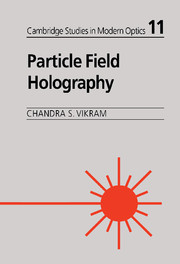Book contents
- Frontmatter
- Contents
- Foreword
- Preface
- Acknowledgements
- 1 Historical background
- 2 Introduction to holography
- 3 General theory of in-line Fraunhofer holography
- 4 System design considerations
- 5 Practical considerations
- 6 Analysis of reconstruction
- 7 Aberrations and their control
- 8 Hologram fringe-contrast and its enhancement
- 9 Non-image plane analysis
- 10 Velocimetry and high speed holography
- 11 The off-axis approach
- References
- Index
6 - Analysis of reconstruction
Published online by Cambridge University Press: 13 October 2009
- Frontmatter
- Contents
- Foreword
- Preface
- Acknowledgements
- 1 Historical background
- 2 Introduction to holography
- 3 General theory of in-line Fraunhofer holography
- 4 System design considerations
- 5 Practical considerations
- 6 Analysis of reconstruction
- 7 Aberrations and their control
- 8 Hologram fringe-contrast and its enhancement
- 9 Non-image plane analysis
- 10 Velocimetry and high speed holography
- 11 The off-axis approach
- References
- Index
Summary
Once a hologram of an event is successfully recorded, the reconstruction at proper net magnification will yield images of the microobjects distinct in the background. As seen in Chapter 3, the image represents the object cross-section encountered at the time of recording. Generally knowledge of net transverse magnification is required for size analysis. Information about the volume magnification is also often needed for determining the density of microobjects.
The net transverse magnification is generally several hundred (see Section 4.9). This results in a limited field of view on a fixed cross-section observation screen. To cover a considerable subject or image volume, either a detector such as the television camera or the hologram on a translation stage is moved for frame by frame analysis. For the general case of a spherical recording and/or reconstruction beam, the magnifications are not straightforward.
The transverse magnification due to the camera-lens system is fixed for a given lens–screen (or vidicon) separation. This magnification can be easily determined by calibration using a resolution chart or a transparent ruler scale. However, the holographic magnification due to the spherical beams is space variant. These magnifications are described in detail in this chapter.
The analysis is generally valid for in-line as well as off-axis holography. We start with the reconstructed image position known in terms of the object, reference and reconstruction source points, and wavelengths of light sources. The needed magnifications are then discussed for modes suited to users of the technique.
- Type
- Chapter
- Information
- Particle Field Holography , pp. 116 - 137Publisher: Cambridge University PressPrint publication year: 1992



